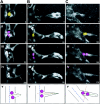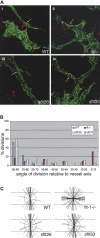Orientation of endothelial cell division is regulated by VEGF signaling during blood vessel formation
- PMID: 17068148
- PMCID: PMC1794069
- DOI: 10.1182/blood-2006-07-037952
Orientation of endothelial cell division is regulated by VEGF signaling during blood vessel formation
Abstract
New blood vessel formation requires the coordination of endothelial cell division and the morphogenetic movements of vessel expansion, but it is not known how this integration occurs. Here, we show that endothelial cells regulate division orientation during the earliest stages of blood vessel formation, in response to morphogenetic cues. In embryonic stem (ES) cell-derived vessels that do not experience flow, the plane of endothelial cytokinesis was oriented perpendicular to the vessel long axis. We also demonstrated regulated cleavage orientation in vivo, in flow-exposed forming retinal vessels. Daughter nuclei moved away from the cleavage plane after division, suggesting that regulation of endothelial division orientation effectively extends vessel length in these developing vascular beds. A gain-of-function mutation in VEGF signaling increased randomization of endothelial division orientation, and this effect was rescued by a transgene, indicating that regulation of division orientation is a novel mechanism whereby VEGF signaling affects vessel morphogenesis. Thus, our findings show that endothelial cell division and morphogenesis are integrated in developing vessels by flow-independent mechanisms that involve VEGF signaling, and this cross talk is likely to be critical to proper vessel morphogenesis.
Figures







Similar articles
-
The VEGF receptor Flt-1 spatially modulates Flk-1 signaling and blood vessel branching.J Cell Biol. 2008 Jun 2;181(5):847-58. doi: 10.1083/jcb.200709114. Epub 2008 May 26. J Cell Biol. 2008. PMID: 18504303 Free PMC article.
-
The vascular endothelial growth factor (VEGF) receptor Flt-1 (VEGFR-1) modulates Flk-1 (VEGFR-2) signaling during blood vessel formation.Am J Pathol. 2004 May;164(5):1531-5. doi: 10.1016/S0002-9440(10)63711-X. Am J Pathol. 2004. PMID: 15111299 Free PMC article.
-
The VEGF receptor flt-1 (VEGFR-1) is a positive modulator of vascular sprout formation and branching morphogenesis.Blood. 2004 Jun 15;103(12):4527-35. doi: 10.1182/blood-2003-07-2315. Epub 2004 Feb 24. Blood. 2004. PMID: 14982871
-
VEGF-directed blood vessel patterning: from cells to organism.Cold Spring Harb Perspect Med. 2012 Sep 1;2(9):a006452. doi: 10.1101/cshperspect.a006452. Cold Spring Harb Perspect Med. 2012. PMID: 22951440 Free PMC article. Review.
-
Role of the vascular endothelial growth factor isoforms in retinal angiogenesis and DiGeorge syndrome.Verh K Acad Geneeskd Belg. 2005;67(4):229-76. Verh K Acad Geneeskd Belg. 2005. PMID: 16334858 Review.
Cited by
-
Signaling pathways triggered by oxidative stress that mediate features of severe retinopathy of prematurity.JAMA Ophthalmol. 2013 Jan;131(1):80-5. doi: 10.1001/jamaophthalmol.2013.986. JAMA Ophthalmol. 2013. PMID: 23307212 Free PMC article.
-
Ensemble analysis of angiogenic growth in three-dimensional microfluidic cell cultures.PLoS One. 2012;7(5):e37333. doi: 10.1371/journal.pone.0037333. Epub 2012 May 25. PLoS One. 2012. PMID: 22662145 Free PMC article.
-
Newly identified biologically active and proteolysis-resistant VEGF-A isoform VEGF111 is induced by genotoxic agents.J Cell Biol. 2007 Dec 17;179(6):1261-73. doi: 10.1083/jcb.200703052. J Cell Biol. 2007. PMID: 18086921 Free PMC article.
-
Neutralizing antibody to VEGF reduces intravitreous neovascularization and may not interfere with ongoing intraretinal vascularization in a rat model of retinopathy of prematurity.Mol Vis. 2008 Feb 11;14:345-57. Mol Vis. 2008. PMID: 18334951 Free PMC article.
-
Advances in understanding and management of retinopathy of prematurity.Surv Ophthalmol. 2017 May-Jun;62(3):257-276. doi: 10.1016/j.survophthal.2016.12.004. Epub 2016 Dec 22. Surv Ophthalmol. 2017. PMID: 28012875 Free PMC article. Review.
References
-
- Risau W. Mechanisms of angiogenesis. Nature. 1997;386:671–674. - PubMed
-
- Eichmann A, Makinen T, Alitalo K. Neural guidance molecules regulate vascular remodeling and vessel navigation. Genes Dev. 2005;19:1013–1021. - PubMed
-
- Coultas L, Chawengsaksophak K, Rossant J. Endothelial cells and VEGF in vascular development. Nature. 2005;438:937–945. - PubMed
-
- Rousseau S, Houle F, Huot J. Integrating the VEGF signals leading to actin-based motility in vascular endothelial cells. Trends Cardiovasc Med. 2000;10:321–327. - PubMed
-
- Kliche S, Waltenberger J. VEGF receptor signaling and endothelial function. IUBMB Life. 2001;52:61–66. - PubMed
Publication types
MeSH terms
Substances
Grants and funding
LinkOut - more resources
Full Text Sources
Molecular Biology Databases
Research Materials

